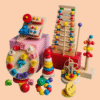When it comes to choosing the right toys for your child, the decision is more impactful than you might think. In India, parents are increasingly shifting from flashy plastic toys to Montessori-inspired learning tools that promise better developmental outcomes. But what’s the real difference between Montessori toys vs traditional toys? Let’s find out.
What Are Montessori Toys?
Montessori toys are designed based on the Montessori method of education developed by Dr. Maria Montessori. These toys are:
- Made from natural materials like wood or cloth
- Encourage hands-on learning and self-correction
- Focused on developing fine motor skills, problem-solving, and independence
- Free from electronics, batteries, or sound/light distractions
Example: Montessori Spelling Board teaches spelling while also improving coordination.
What Defines Traditional Toys?
Traditional toys in today’s market often refer to mass-produced plastic toys found in toy shops or supermarkets. These may include:
- Bright, noisy, and often battery-operated
- Feature characters from movies or cartoons
- Primarily focused on entertainment over learning
- Shorter shelf-life due to breakability and overstimulation
While they might engage a child’s attention instantly, they often don’t support deeper learning or long-term cognitive development.
Key Differences: Montessori vs Traditional Toys
| Feature | Montessori Toys | Traditional Toys |
|---|---|---|
| Material | Natural (Wood, Cloth) | Plastic, Electronic |
| Learning | Educational & Purposeful | Entertainment-based |
| Engagement | Deep focus, longer play | Quick interest, short play |
| Durability | Long-lasting | Breakable |
| Development | Promotes independence | Often encourages passive play |
Benefits of Montessori Toys in Indian Households
Parents in India are recognizing the following advantages:
- Reduced screen addiction
- Better emotional regulation
- Improved hand-eye coordination
- Longer attention spans
Montessori Puzzle Game is an excellent example that promotes logical thinking while being fun.
Parent Experiences: Real-Life Results
Parents report improved behavior, calmness, and creativity in children who use Montessori toys. Unlike traditional toys that may result in overstimulation, Montessori alternatives help children manage emotions better and enjoy independent play.
Testimonial: “After switching to NiraToys Montessori products, my son spends more time building and learning than watching cartoons.”
Are Montessori Toys Worth the Price?
While Montessori toys may seem slightly more expensive upfront, they provide years of value due to:
- Sturdiness
- Multi-age usability
- Reusability for siblings
- Educational enrichment
It’s a one-time investment with long-term developmental returns.
Choosing the Right Toy for Your Child’s Age
Every Montessori toy serves a purpose based on age group:
- 1–2 Years: Color Classification Maze, Shape Sorters
- 2–3 Years: Memory Chess Game, Sorting Blocks
- 3+ Years: Montessori Spelling Board, Puzzle Games
NiraToys Picks: Montessori Alternatives to Common Toys
| Traditional Toy | Montessori Alternative | Product Link |
| Battery Keyboard | Wooden Drum Keyboard | Link |
| Plastic Puzzle | Wooden Montessori Puzzle | Link |
| LED Car Track | Wooden Ramp Race | Link |
| Flashcards | Self-Correcting Spelling Board | Link |
Final Thoughts
Montessori toys vs traditional toys isn’t just a trendy comparison. It’s about choosing between passive consumption vs active development.
In today’s fast-paced Indian parenting journey, Montessori toys offer a mindful, development-rich experience that sets the foundation for lifelong learning.
✅ CTA:
Switch to Montessori – Safer, Smarter, Sustainable
👉 Explore Montessori Collection




